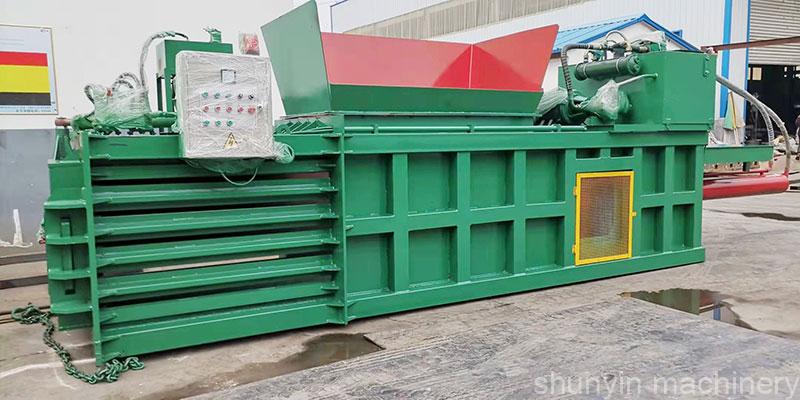
Managing cardboard waste efficiently is a challenge many businesses face today. Finding the right equipment can transform your waste management process, saving time and resources.
The best horizontal hydraulic baler brands for cardboard include Shunyin, known for high-quality, customizable machines at competitive prices. Other top brands are Harris, Vollenda, and Maren Engineering. These manufacturers offer durable, efficient balers designed specifically for cardboard, providing optimal compaction, reducing storage space, and improving recycling processes for businesses handling large volumes of cardboard waste.
I remember when we first struggled with inconsistent baler performance. It was frustrating until we discovered the right brands that made all the difference.
Is a cardboard baler worth it?
Investing in a cardboard baler can streamline your waste management, reduce costs, and enhance recycling efforts.

Implementing a cardboard baler has transformed how we handle waste. Initially hesitant, the benefits quickly became evident.
Benefits of Using a Cardboard Baler
- Cost Savings: Reduces waste disposal fees.
- Space Efficiency: Compacts cardboard, saving storage space.
- Environmental Impact: Promotes recycling and sustainability.
| Benefit | Description |
|---|---|
| Cost Savings | Lower disposal and transportation costs. |
| Space Efficiency | Less space needed for storing waste. |
| Environmental Impact | Supports eco-friendly recycling practices. |
Real-World Applications
In our factory, the baler has minimized our waste footprint. We’ve seen a 30% reduction in waste disposal costs within the first year.
Choosing the Right Baler
Selecting a baler that fits your business size and waste volume is crucial. Consider factors like machine size, capacity, and maintenance requirements.
How many pounds of pressure does a cardboard baler have?
Cardboard balers typically exert between 15,000 to 30,000 pounds of pressure to effectively compress cardboard.

Understanding the pressure a baler applies is key to ensuring it meets your operational needs.
Pressure Range and Its Importance
- 15,000 Pounds: Suitable for small to medium operations.
- 30,000 Pounds: Ideal for larger businesses with higher waste volumes.
| Pressure Level | Suitable For |
|---|---|
| 15,000 Pounds | Small to medium-sized businesses |
| 30,000 Pounds | Large enterprises with significant waste |
Impact on Baling Efficiency
Higher pressure results in more compact bales, optimizing storage and transportation. However, it’s essential to balance pressure with the baler’s capacity to avoid mechanical strain.
Maintenance Considerations
Regular maintenance ensures the baler operates at optimal pressure levels. Monitoring hydraulic systems and pressure gauges is essential for longevity and performance.
What is the difference between a bailer and a baler?
Balers compress materials like cardboard into dense bales, while bailers are typically used for collecting and storing loose materials.

Differentiating between bailers and balers helps in selecting the right equipment for your needs.
Functionality Comparison
- Baler:
- Compresses materials into compact bales.
- Enhances storage efficiency.
- Bailer:
- Collects and stores loose materials.
- Often used in agricultural or waste collection contexts.
| Feature | Baler | Bailer |
|---|---|---|
| Compression | High pressure to create dense bales | Minimal to no compression |
| Primary Use | Recycling, waste management | Collection and storage of loose waste |
| Efficiency | High storage efficiency | Lower storage efficiency |
Choosing Between Baler and Bailer
Assess your business needs to determine which machine aligns with your waste management strategy. For recycling and storage efficiency, a baler is the optimal choice.
Case Study
At Shunyin, we’ve transitioned from using bailers to balers to meet our growing recycling demands. This shift has enhanced our operational efficiency and reduced waste management costs.
What is the machine that crushes cardboard called?
The machine used to crush cardboard is commonly referred to as a cardboard crusher or a hydraulic baler.

Crushing cardboard is a critical step in efficient waste management, and understanding the terminology helps in selecting the right equipment.
Cardboard Crusher vs. Hydraulic Baler
- Cardboard Crusher:
- Specifically designed to break down cardboard into smaller pieces.
- Facilitates easier transportation and recycling.
- Hydraulic Baler:
- Compresses cardboard into bales for storage and transport.
- Often equipped with crushing capabilities as part of the baling process.
Features of a Cardboard Crusher
- High Torque Motors: Ensure effective crushing of thick cardboard.
- Durable Construction: Made from heavy-duty materials to withstand constant use.
- Ease of Operation: User-friendly interfaces for efficient operation.
Integrating Crushers with Balers
Many modern balers incorporate crushing functions, providing a comprehensive solution for cardboard waste management. This integration enhances overall efficiency by reducing the volume before baling.
| Machine Type | Primary Function | Additional Features |
|---|---|---|
| Cardboard Crusher | Breaks down cardboard into smaller pieces | High torque motors, durable build |
| Hydraulic Baler | Compresses cardboard into bales | Crushing capabilities, high pressure |
Selecting the Right Machine
Consider your volume of cardboard waste and the specific needs of your operation. For high-volume businesses, a combined crusher and baler system may offer the best efficiency and cost-effectiveness.
Conclusion
Choosing the right horizontal hydraulic baler can transform your cardboard recycling process, offering efficiency, cost savings, and sustainability. At Shunyin, we provide top-quality, customizable machines to meet your business needs.








